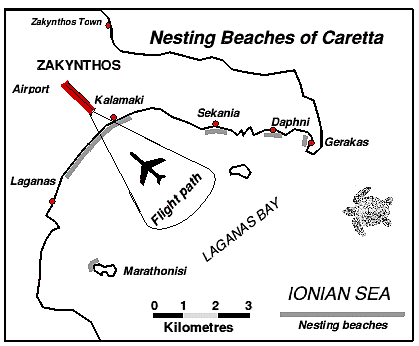On
the island of Zakynthos (Greece), there has been a specific threat
from the close proximity of the main runway to key nesting beaches
for the Loggerhead Sea Turtle - Caretta caretta. This section highlights
this threat and reveals some of the conflicts and solutions that
have emerged as a result.
- Zakynthos
airport is located in the south of the island and the end of the
runway is within 1 kilometre of the key nesting beaches of Kalamaki
and Laganas. The beaches near this flight path account for approximately
20% of the total nests in Laganas Bay, one of the most important
shores for nesting Caretta caretta in the Mediteranean. ( Average
number of nests for 1984-90 season in Laganas Bay was 1269 - data
from Margaritoulis & Arapis))
The
following map shows the location of the airport and the close vicinity
of nesting beaches.

Every
year nearly 300,000 tourists visit the island, the vast majority
arriving by air from all over Europe. There are many flights per
day, all landing at this airport ( during July 1996, 313 flights
arrived at the airport, an average of 10 flights per day and 45,876
tourists for the month - source MEDASSET,1996).
- The
jets fly very low over the beach after an approach across Laganas
Bay. On some days they will approach from the northern part of
the island, although this is not a common event. The following
photographs were taken in 1993, whilst standing at the end of
the runway, which is located less than 1 kilometre from nesting
beaches.


 |
Eyewitness
account: Miles Smith (July 1993) |
"
We waded out until the water almost covered our shoulders.
We could see loggerheads about 50m away, as their heads 'bobbed'
up for air. In the distance far out over the bay, we could
see an approaching jet. It banked and came directly towards
us. As it approached, the roar steadily increased and it passed
directly over our heads: it was so close you could easily
make out the details of the fuselage and the under-carriage.
We could also feel the vibrations as it passed through the
water into our bodies. As the jet passed, there was a high
whistle form the plane's jet-stream. A few minutes later ,you
could hear the 'reverse' engine roar as the aeroplane slowed
itself for a safe landing and deliver yet more tourists for
a two week holiday on the island. "
A
study in 1990 by the National Aviation Service on the impacts
of the airport on nesting sea turtles showed clearly that
significant disturbance occurred to nesting loggerheads. The
greatest disturbance would occur at night and cause females
to return to the sea without successful laying.
In
1990, the airport of Zakynthos banned flights between 22:00
and 5:00. In 1996, Olympic Airways rescheduled its last daily
flight from Zakynthos to Athens, in order to avoid breaching
of the ban.
To
hear the sound of the jet flying over the nesting beach
- click on the overhead plane.
Conflict
of interests (June 20 1995) :

Extract
from the Times article:
British toursists bound for Greece began their holiday a
day late after an airport closed to allow a colony of rare
turtles to lay their eggs.
A
flight from Manchester to the Ionian Island of Zakynthos
was delayed overnight to spare endangered loggerhead turtles
the trauma of aircraft landing next to their nesting beach.
The turtles lay only at night and are susceptible to noise
and light.
The
200 Britons had expected to leave Manchester on Sunday afternoon
but a technical fault delayed them for an hour. After spending
the night at Hotels, passengers left nine hours behind schedule
when Zakynthos airport reopened at 6am.
Nick
Humphries, of the tour operator All Leisure, said: "The
airport closes from 7pm until the early morning during the
nesting season and our aircraft would not have got there
before 7pm. It would probably have been diverted to the
Greek mainland and the decision was taken to wait. It is
proving a difficult problem for us. "
The
arrival of summer package tourists each year conicides with
the nesting and hatching season of the loggerhead. Tourist
numbers have risen sharply the past five years and 40 per
cent of the 300,000 tourists that visit the island are British.
(The
article continues with a discussion of illegal buildings
which threaten nesting turtles)
|
Extract
from the Daily Mail article:
As
an excuse for lateness it beats British Rail's leaves on the line.
But
Holidaymakers waiting to fly out from Manchester Airport were less
than amused to hear that their plane had been delayed to allow turtles
to breed in peace......................
The
plane finally took off yesterday, nine hours behind schedule. A
spokesman for the All Leisure airline said: "The turtles are
an endangered species and Zante airport closes from 7pm until the
early hours during the breeding season. We are trying to reschedule
our take-off times so everyone is happy."
--------------------------------------------------------------------------------
Comment
The
brief and trivial nature of the report on the Airport delay of tourists
to Zakynthos implies that 200 British tourists were unecessarily
discomfited because of the activities of a small group of interfering
conservationists on behalf of an important colony of Mediterranean
turtles whose protection is opposed by all the Greeks on the island.
The
plane was late in leaving because of reasons nothing to do with
marine turtles. This then meant that the plane would leave too late
to arrive within the limits of the night time flying ban.
In
reality the night flying ban that caused the delay is part of a
well-integrated set of laws, set by the Greek Government and financially
supported by the European Union, that seeks to protect the turtle
and its breeding sites. There is a total exclusion order for these
beaches from dusk to dawn. Unfortunately these laws have been poorly
implemented.
There
is, or course, strong opposition from some local people, mostly
small landowners and particularly those making a living from beach
activities. However, there is also strong support for conservation
of the Loggerhead turtle both in Greece and on the Island. Among
the groups conerned are the Sea Turtle Protection Society of Greece
(STPS), MEDASSET (Mediterranean Association to Save the Sea Turtles)
Greece and UK, WWF (Greece), Greenpeace (Greece), The Zakynthos
Ecological Movement and the the Zakynthos Hotel Owners Association
(ETAZ).
All
these groups support the Government's legislation and its plans
for a Marine National Park. A recent survey carried out in 1995
by the STPS suggested that 90% of visiting tourists supported the
idea of a National Marine Park and 86% were willing to pay a surcharge
towards the upkeep of the Marine Park.
|
|





